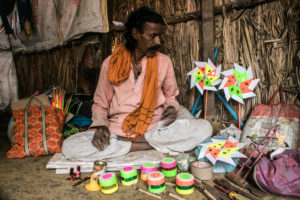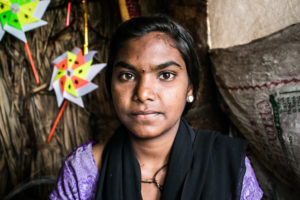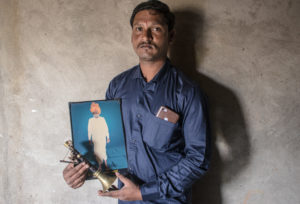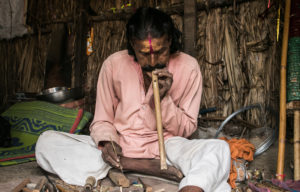By Sanket Jain
Photos by Sanket Jain
Narayan Desai, a traditional toymaker in India, has 1000 sheets of colorful paper – each a meter long—to make 12,000 pinwheels. It takes him roughly 200 hours of work over 24 days in order to convert the paper into that many pinwheels. In normal times, the 62-year-old toymaker would then travel to over 100 villages – covering 1000 miles to sell each pinwheel for Rs 10 (14 cents).
This was Narayan’s routine for over four decades. However, in this year of the coronavirus pandemic, he managed to cover only 20 miles in eleven months. February 24 was the last he could sell pinwheels and other toys he handcrafts – earning only the equivalent of $27.00 in two days. Narayan didn’t know he would have to survive on this paltry sum for the next eight months.
On March 24th, the Indian government declared a 21-day lockdown. However, it was later extended by another 19 days, then 14 days and in the end by another 14 days which collectively made it last almost 10 weeks, wreaking havoc on the economy and restricting the movement of 1.3 billion people – all with a notice of merely four hours.
Narayan – like 121 million Indians who lost their jobs within a month of the lockdown, had no means to prepare for the catastrophe. The lockdown coincided with yatras (annual village fairs) that remain an open marketplace for several traditional rural toymakers. In the western and southern Indian states of Maharashtra and Karnataka, these cultural fairs, dedicated to local deities, are spread across 2-3 days dating back several centuries. With India reaching 9.97 million COVID cases as of 17 December, public gatherings, including the village fairs across India, remain banned. Traditional toymaking – as little and unheard of as it remains today –is now at the risk of going extinct.

Narayan, who’s from a village in the Belagavi district in the southern Indian state of Karnataka, would usually travel to the three different states of Goa, Maharashtra, and Karnataka to sell his toys. He belongs to the Holar caste – whose members include master players of the traditional Dafda (tambourine) and the Shehnai (a double-reed conical woodwind instrument) Earlier, Holars were invited to the villages of Maharashtra and Karnataka during marriages and religious occasions to play the tambourine and shehnai. “We were never allowed to enter the temples. Even today, we don’t enter a temple. We stand outside on the street and play,” says Narayan – highlighting the casteism and untouchability that prevail even today.
At the age of 12, he began cycling hundreds of miles with his father and grandfather – often dancing to the notes of the shehnai wind instrument. Gradually, he learned to play both the shehnai and the flute. “Whenever we were free, my father and grandfather would make flutes and shehnais,” he reminisces.
Toys are now threatened as well
With the advent of musical bands in the early 1950s, the demand for traditional instruments lessened. As a result, artists formed or joined musical bands where they played a variety of new instruments. Narayan then turned to handcrafting toys, and in a few years, added over 10 toys to his repertoire. “My father used to make pinwheels, but you can’t survive only on one toy,” he told me. Some of the toys he makes include different types of origami birds, wooden carts and sound-making spring toys (that is, toys such as simple horse toys, with a spring attached that helps them bounce forward and backward or upward and downward). These toys don’t sell in the stores or shops. “Only in village fairs or festivals can children buy them,” he explained. In this work, “you have to keep traveling – expecting someone will buy your toys.” In normal times he would average a monthly income of $100.00 from this work – putting in almost ten hours daily.
He finds it difficult to trade in cities and towns. “Now, the kids don’t play with the toys I make. They use phones,” he says. This trend is spreading into rural areas too. “During the lockdown, barely five local villagers came to my house to buy toys.” Another issue is the cheaper plastic toys flooding the rural markets.
A 2020 International Labour Organisation report warns that “in India, with a share of almost 90 per cent of people working in the informal economy, about 400 million workers in the informal economy are at risk of falling deeper into poverty.”
According to an Indian think tank, The Centre for Monitoring the Indian Economy, India lost 121 million jobs that included 91 million daily wage labourers falling under the informal economy in the month of April.
How Narayan Copes Today
From making paper flutes to ones made from high-quality bamboo and sagwan (teak), Narayan perfected seven variations of the flute. Depending on their use and complexity, he charges between 30 cents and $6.00 to handcraft a flute.
In October, he got an order of 144 flutes from an old customer, who’s now a school headmaster. “I don’t have enough money to buy the raw materials,” Narayan says. Another hindrance is the lack of availability of raw materials, for which he has to travel 58 miles in order to handpick the best of the lot. The type of flute he handcrafts, he proudly says, “won’t crack for at least 20 years.”
His partner, Sushila, in her late 40s, and his grand-daughter, Neelam, 18, help him with his toymaking work.

With their support, Narayan has been able to handcraft multiple toys. “She’s a much better artist than I am,” he says smilingly. Sushila doubles up as a laborer – lifting heavy industrial machinery and metal parts. For ten hours of work, she gets $3.00. “Our toy-making business is completely devastated by Corona and the lockdown,” she dismays. Her younger daughter, Rekha, in her late 30s, assists her as a laborer, while the elder daughter, Alka, passed away 15 years ago.
Because of his old age, Narayan has been seeking the help of agents to sell his toys at the commission rate of 30 percent. “It’s not affordable, but at least there’s some sale that brings in food,” he says. Previously, every year he managed to sell at least 500 flutes of different calibrations and over ten shehnais. This year, it came down to a mere four flutes and two shehnais. These numbers describe the plight of traditional rural artists – who even today are classified under the ‘informal economy’ in India. With no recognition, accreditation, and livelihood security, some of the finest artists are now forced to work as farm workers or industrial laborers.

Narayan’s grandnephew, Arjun Javir, 25, remains the only artist from the younger generation who plays the shehnai in the same Mankapur village. “Playing a shehnai for a long time causes breathlessness. It’s a lot of effort and doesn’t even pay enough to eat food twice a day,” Narayan explains. Arjun, who is attempting to keep the art form alive, has learned 16 musical instruments so far and aims to make a career in music. However, with all the occasions abandoned in the lockdown, he is now forced to pick odd jobs to make ends meet.
On 25th October, Narayan was invited to play the shehnai for ten days in a nearby village for which he was paid $5.00 daily. However, after spending over 60 hours in performances, he experienced breathlessness and fatigue. The result: he was hospitalised and given intravenous drips of saline solution and electrolytes. “Even today, I feel dizzy and weak,” he says.
In an attempt to make ends meet, Narayan even tried selling balloons outside a village temple. “This year, the local police didn’t allow us to sit on the road and sell toys,” he says. Inflating the balloons manually and selling them brings in an income, especially during the festival of Diwali (dates vary every year between October and November), where Narayan managed to earn $10.00 in three days.
Over four decades, he has trained 15 artists. However, barely two of them have kept the art alive. He’s the last generation toymaker and a flute and shehnai craftsperson in his village. “The younger generations don’t want to learn this art, but they should understand that skills are important,” he explains, adding that as artists, they feel ashamed of having to play a shehnai on the road instead of being allowed to play in a temple.
In the late 1960s, there were more than 20 flutists and shehnai masters in the village. Today, it is down to the last four. Laments Narayan, “Our art form remained behind.”

Bajrang Desai, another artist from Maharashtra’s Kolhapur district, stopped crafting flutes 12 years ago, picking the job of a lab assistant in a private school. “Several substandard flutes sell for much cheaper than the one we make. I’ve been handcrafting and selling the flute from the 1960s, but now it’s not possible to survive on this,” Bajrang says.
Dinkar Aiwale, 74, a last generation flute maker from Maharashtra, has been traveling like Narayan for over five decades. He says, “In the past eight months, I have not been able to sell a single flute. We didn’t receive any help from the Government, either.”
Narayan, from the time he was 12 until now, has hand made over half a million pinwheels. Despite the steady decline in craft, his work has never halted. Now, for the first time in four decades, he’s been forced to take a break of eight months and now stares at an uncertain future.
As of today, the fairs remain banned. Now he awaits the end of January in hopes that the fairs will resume. “I hope by then the Government permits fairs to start up again,” he says. “If the markets don’t recover soon, this occupation will die.”
Sanket Jain is an independent journalist based in the Kolhapur district of Western India. He is also a 2019 People’s Archive of Rural India fellow where he is documenting vanishing art forms from the Indian countryside. He has written for the Baffler, Progressive Magazine, Counterpunch, Byline Times, The National, Popula, Media Co-op, and Indian Express.
